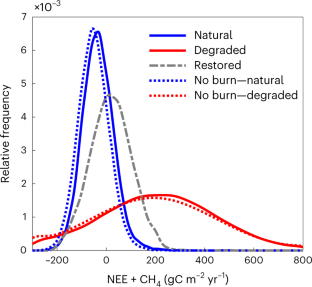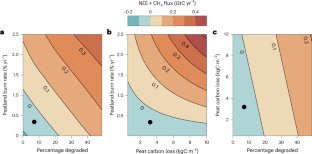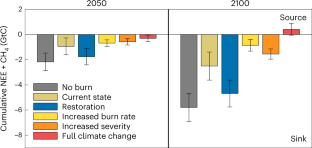Abstract
The northern peatland carbon sink plays a vital role in climate regulation; however, the future of the carbon sink is uncertain, in part, due to the changing interactions of peatlands and wildfire. Here, we use empirical datasets from natural, degraded and restored peatlands in non-permafrost boreal and temperate regions to model net ecosystem exchange and methane fluxes, integrating peatland degradation status, wildfire combustion and post-fire dynamics. We find that wildfire processes reduced carbon uptake in pristine peatlands by 35% and further enhanced emissions from degraded peatlands by 10%. The current small net sink is vulnerable to the interactions of peatland degraded area, burn rate and peat burn severity. Climate change impacts accelerated carbon losses, where increased burn severity and burn rate reduced the carbon sink by 38% and 65%, respectively, by 2100. However, our study demonstrates the potential for active peatland restoration to buffer these impacts.
This is a preview of subscription content, access via your institution
Access options
Access Nature and 54 other Nature Portfolio journals
Get Nature+, our best-value online-access subscription
$29.99 per month
cancel any time
Subscribe to this journal
Receive 12 print issues and online access
$209.00 per year
only $17.42 per issue
Rent or buy this article
Get just this article for as long as you need it
$39.95
Prices may be subject to local taxes which are calculated during checkout



Data availability
Synthesized data are uploaded to a certified repository55 and are open access.
Code availability
Model simulations code is uploaded to a certified repository55 and is open access.
References
-
Yu, Z., Loisel, J., Brosseau, D. P., Beilman, D. W. & Hunt, S. J. Global peatland dynamics since the Last Glacial Maximum. Geophys. Res. Lett. 37, L13402 (2010).
-
Xu, J., Morris, P. J., Liu, J. & Holden, J. PEATMAP: refining estimates of global peatland distribution based on a meta-analysis. Catena 160, 134–140 (2018).
-
Hugelius, G. et al. Large stocks of peatland carbon and nitrogen are vulnerable to permafrost thaw. Proc. Natl Acad. Sci. USA 117, 20438–20446 (2020).
-
Frolking, S. & Roulet, N. T. Holocene radiative forcing impact of northern peatland carbon accumulation and methane emissions. Glob. Change Biol. 13, 1079–1088 (2007).
-
Gallego-Sala, A. V. et al. Latitudinal limits to the predicted increase of the peatland carbon sink with warming. Nat. Clim. Change 8, 907–913 (2018).
-
Ferretto, A., Brooker, R., Aitkenhead, M., Matthews, R. & Smith, P. Potential carbon loss from Scottish peatlands under climate change. Reg. Environ. Change 19, 2101–2111 (2019).
-
Loisel, J. et al. Expert assessment of future vulnerability of the global peatland carbon sink. Nat. Clim. Change 11, 70–77 (2020).
-
Kettridge, N. et al. Moderate drop in water table increases peatland vulnerability to post-fire regime shift. Sci. Rep. 5, 8063 (2015).
-
Turetsky, M. R. et al. Global vulnerability of peatlands to fire and carbon loss. Nat. Geosci. 8, 11–14 (2015).
-
Wilkinson, S. L., Moore, P. A., Flannigan, M. D., Wotton, B. M. & Waddington, J. M. Did enhanced afforestation cause high severity peat burn in the Fort McMurray Horse River wildfire? Environ. Res. Lett. 13, 014018 (2018).
-
Joosten, H. et al. in Global Peatlands Assessment: The State of the World’s Peatlands Global Peatlands Initiative (Main Report) 53–56 (UNEP, 2022).
-
Leifeld, J., Wüst-Galley, C. & Page, S. Intact and managed peatland soils as a source and sink of GHGs from 1850 to 2100. Nat. Clim. Change 9, 945–947 (2019).
-
Humpenöder, F. et al. Peatland protection and restoration are key for climate change mitigation. Environ. Res. Lett. 15, 104093 (2020).
-
Poulter, B., Christensen, N. L. & Halpin, P. H. Carbon emissions from a temperate peat fire and its relevance to interannual variability of trace atmospheric greenhouse gases. J. Geophys. Res. 111, 6301 (2006).
-
Turetsky, M. R., Donahue, W. F. & Benscoter, B. W. Experimental drying intensifies burning and carbon losses in a northern peatland. Nat. Commun. 2, 514 (2011).
-
Wieder, R. K. et al. Postfire carbon balance in boreal bogs of Alberta, Canada. Glob. Change Biol. 15, 63–81 (2009).
-
Kuhry, P. The role of fire in the development of sphagnum-dominated peatlands in western boreal Canada. J. Ecol. 82, 899–910 (1994).
-
Ingram, R. C., Moore, P. A., Wilkinson, S. L., Petrone, R. M. & Waddington, J. M. Postfire soil carbon accumulation does not recover boreal peatland combustion loss in some hydrogeological settings. J. Geophys. Res.124, 775–788 (2019).
-
McCarter, C. P. R., Wilkinson, S. L., Moore, P. A. & Waddington, J. M. Ecohydrological trade-offs from multiple peatland disturbances: the interactive effects of drainage, harvesting, restoration and wildfire in a southern Ontario bog. J. Hydrol. 601, 126793 (2021).
-
Davies, G. M., Gray, A., Rein, G. & Legg, C. J. Peat consumption and carbon loss due to smouldering wildfire in a temperate peatland. For. Ecol. Manag. 308, 169–177 (2013).
-
Leifeld, J. & Menichetti, L. The underappreciated potential of peatlands in global climate change mitigation strategies. Nat. Commun. 9, 1071 (2018).
-
Davidson, S. J., Van Beest, C., Petrone, R. & Strack, M. Wildfire overrides hydrological controls on boreal peatland methane emissions. Biogeosciences 16, 2651–2660 (2019).
-
Gray, A., Davies, G. M., Domènech, R., Taylor, E. & Levy, P. E. Peatland wildfire severity and post-fire gaseous carbon fluxes. Ecosystems 24, 713–725 (2020).
-
Morison, M. Q., Petrone, R. M., Wilkinson, S. L., Green, A. & Waddington, J. M. Ecosystem scale evapotranspiration and CO2 exchange in burned and unburned peatlands: implications for the ecohydrological resilience of carbon stocks to wildfire. Ecohydrology 13, e2189 (2020).
-
Hanes, C. C. et al. Fire-regime changes in Canada over the last half century. Can. J. For. Res. 49, 256–269 (2019).
-
Jain, P., Castellanos-Acuna, D., Coogan, S. C. P., Abatzoglou, J. T. & Flannigan, M. D. Observed increases in extreme fire weather driven by atmospheric humidity and temperature. Nat. Clim. Change 12, 63–70 (2021).
-
Helbig, M. et al. Increasing contribution of peatlands to boreal evapotranspiration in a warming climate. Nat. Clim. Change 10, 555–560 (2020).
-
Hari, V., Rakovec, O., Markonis, Y., Hanel, M. & Kumar, R. Increased future occurrences of the exceptional 2018–2019 Central European drought under global warming. Sci. Rep. 10, 12207 (2020).
-
Swindles, G. T. et al. Widespread drying of European peatlands in recent centuries. Nat. Geosci. 12, 922–928 (2019).
-
Púčik, T. et al. Future changes in European severe convection environments in a regional climate model ensemble. J. Clim. 30, 6771–6794 (2017).
-
Mickler, R. A., Welch, D. P. & Bailey, A. D. Carbon emissions during wildland fire on a North American temperate peatland. Fire Ecol. 13, 34–57 (2017).
-
Turetsky, M. R., Amiro, B. D., Bosch, E. & Bhatti, J. S. Historical burn area in western Canadian peatlands and its relationship to fire weather indices. Glob. Biogeochem. Cycles 18, GB4014 (2004).
-
Mahood, A. L., Lindrooth, E. J., Cook, M. C. & Balch, J. K. Country-level fire perimeter datasets (2001–2021). Sci. Data 9, 458 (2022).
-
Crump, J. Smoke on Water: Countering Global Threats from Peatland Loss and Degradation (GRID-Arendal, 2017); https://www.grida.no/publications/355
-
Granath, G., Moore, P. A., Lukenbach, M. C. & Waddington, J. W. Mitigating wildfire carbon loss in managed northern peatlands through restoration. Sci. Rep. 6, 28498 (2016).
-
Spreading like Wildfire: the Rising Threat of Extraordinary Landscape Fires (UNEP, 2022); https://www.unep.org/resources/report/spreading-wildfire-rising-threat-extraordinary-landscape-fires
-
Thompson, D. K., Simpson, B. N., Whitman, E., Barber, Q. E. & Parisien, M. A. Peatland hydrological dynamics as a driver of landscape connectivity and fire activity in the boreal plain of Canada. Forests 10, 534 (2019).
-
Nelson, K., Thompson, D., Hopkinson, C., Petrone, R. M. & Chasmer, L. Peatland–fire interactions: a review of wildland fire feedbacks and interactions in Canadian boreal peatlands. Sci. Total Environ. 769, 145212 (2021).
-
Harris, L. I. et al. The essential carbon service provided by Northern peatlands. Front. Ecol. Environ. 20, 222–230 (2021).
-
Strack, M., Davidson, S. J., Hirano, T. & Dunn, C. The potential of peatlands as nature-based climate solutions. Curr. Clim. Change Rep. 8, 71–82 (2022).
-
Ganteaume, A. et al. A review of the main driving factors of forest fire ignition over Europe. Environ. Manag. 51, 651–662 (2013).
-
Strack, M. (ed.) Peatlands and Climate Change (IPS, 2008).
-
Wilkinson, S. L., Moore, P. A. & Waddington, J. M. Assessing drivers of cross-scale variability in peat smoldering combustion vulnerability in forested boreal peatlands. Front. For. Glob. Change 2, 84 (2019).
-
Kukavskaya, E. A. et al. Fire emissions estimates in Siberia: evaluation of uncertainties in area burned, land cover, and fuel consumption. Can. J. For. Res. 43, 493–506 (2013).
-
Evans, C. et al. Implementation of an Emissions Inventory for UK Peatlands (Centre for Ecology and Hydrology, 2017).
-
Magnan, G. et al. Widespread recent ecosystem state shifts in high-latitude peatlands of northeastern Canada and implications for carbon sequestration. Glob. Change Biol. 28, 1919–1934 (2022).
-
Beaulne, J., Garneau, M., Magnan, G. & Boucher, É. Peat deposits store more carbon than trees in forested peatlands of the boreal biome. Sci. Rep. 11, 2657 (2021).
-
Webster, K. L. et al. Spatially-integrated estimates of net ecosystem exchange and methane fluxes from Canadian peatlands. Carbon Balance Manage. 13, 16 (2018).
-
Abdalla, M. et al. Emissions of methane from northern peatlands: a review of management impacts and implications for future management options. Ecol. Evol. 6, 7080–7102 (2016).
-
Olson, D. M. et al. Terrestrial ecoregions of the world: a new map of life on Earth. BioScience 51, 933–938 (2001).
-
Gauthier, S., Bernier, P., Kuuluvainen, T., Shvidenko, A. Z. & Schepaschenko, D. G. Boreal forest health and global change. Science 349, 819–822 (2015).
-
QGIS Geographic Information System—Version 3.6 (QGIS Development Team, 2019); http://qgis.osgeo.org
-
Bergeron, Y., Cyr, D., Girardin, M. P. & Carcaillet, C. Will climate change drive 21st century burn rates in Canadian boreal forest outside of its natural variability: collating global climate model experiments with sedimentary charcoal data. Int. J. Wildland Fire 19, 1127–1139 (2010).
-
Kharuk, V. I. et al. Wildfires in the Siberian taiga. Ambio 50, 1953–1974 (2021).
-
Wilkinson, S. L. et al. Dataset and code for ‘Wildfire and degradation accelerate northern peatland carbon release’ (NCLIM-22071425B). Zenodo https://doi.org/10.5281/zenodo.7718628 (2023).
Acknowledgements
The research published in this paper is part of the Boreal Water Futures project, which is funded by the Global Water Futures programme of the Canada First Research Excellence Fund. Funding was also provided by the Canada Wildfire NSERC Strategic Network. R.A. acknowledges funding by the Leverhulme Trust (RL2019-002) and by NERC (NE/T006528/1) and G.G. acknowledges funding from waterLANDS, a European Union Horizon Green Deal project under grant agreement no. 101036484.
Author information
Authors and Affiliations
Contributions
S.W., R.A., S.D. and J.M.W. were responsible for conceptualization. J.M.W. was responsible for funding acquisition and supervision. S.W., P.M., S.D. and G.G. undertook data curation. S.W. and P.M. conducted the formal analysis. S.W., R.A., P.M. and J.M.W. developed the methodology. S.W. and R.A. were responsible for visualization. S.W. and R.A. wrote the original draft and all other authors reviewed and edited the final manuscript.
Corresponding author
Correspondence to
S. L. Wilkinson.
Ethics declarations
Competing interests
The authors declare no competing interests.
Peer review
Peer review information
Nature Climate Change thanks Nancy French and the other, anonymous, reviewer(s) for their contribution to the peer review of this work.
Additional information
Publisher’s note Springer Nature remains neutral with regard to jurisdictional claims in published maps and institutional affiliations.
Extended data
Extended Data Fig. 1 Conceptual diagram of the modelling design.
Conceptual diagram of the modelling design developed to incorporate peat carbon loss from wildfire (peat burn severity) and post-fire carbon dynamics (recovery rate and recovered NEE) in peatland GHG emissions. Where y1 represents the NEE + CH4 of a burned peatland, x1 represents the time lag between wildfire and the initiation of post-fire recovery, x2 represents the time at which ‘recovered’ NEE is achieved and y2 represents the magnitude of the recovered carbon sink. The variability in peat burn severity, time lag, recovery rate, and recovered NEE are depicted by the blue dashed lines and yellow arrows.
Supplementary information
Supplementary Information
Supplementary Tables 2–4 and Figs. 1–4.
Supplementary Table 1
Table of calculated burn rate for each ecoregion that contains histosols.
Rights and permissions
Springer Nature or its licensor (e.g. a society or other partner) holds exclusive rights to this article under a publishing agreement with the author(s) or other rightsholder(s); author self-archiving of the accepted manuscript version of this article is solely governed by the terms of such publishing agreement and applicable law.
About this article
Cite this article
Wilkinson, S.L., Andersen, R., Moore, P.A. et al. Wildfire and degradation accelerate northern peatland carbon release.
Nat. Clim. Chang. (2023). https://doi.org/10.1038/s41558-023-01657-w
-
Received: 29 July 2022
-
Accepted: 17 March 2023
-
Published: 20 April 2023
-
DOI: https://doi.org/10.1038/s41558-023-01657-w










